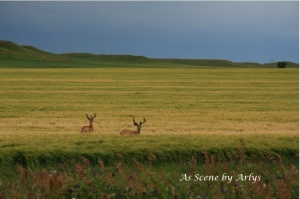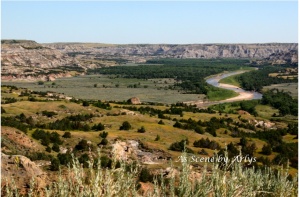August 2, 2010
Traveling as many back roads as possible to attend my grand nieces wedding, I was surprised how incredibly green the landscape was. The weather was perfect traveling through Wyoming and the Dakotas.
Gentle rains freshened the air as intoxicating fragrances from nearby fields of grain nourished my senses. The country side was luxuriantly green. The heads of wheat, flax and oat crops were already bursting at their seams, heavily weighing the stalks that were just beginning to ripen. I couldn’t believe my eyes. I walked into several fields, and to my astonishment the crops were almost to my hips and the growing season was not yet over. There was a bumper crop in the making, and I was ecstatic for the farmers.
I was drawn to take several gravel roads, which beckoned me to explore dirt paths as well. Scurrying along the paths, wild turkeys, pheasants, ducks, fox, geese, and grouse darted in and out of ditches dense with towering, pungent grasses. I never was quick enough to catch them with my camera.
As I walked inhaling the breathless scene around me, I mounted a gentle knoll. Embracing oceans of green stretching for hundreds of miles, I remembered a very different and cruel summer of my youth.
I was quite young when we suffered a severe drought. Spring was particularly disheartening, and foreshadowed a disastrous summer and meager harvest.
My dad came home day after day from spring planting shaking his head in disbelief. The winter had been bitterly cold, and very, very dry. Without snow and early spring rains to saturate the soil it was impossible to plow. When the earth is sufficiently wet, it turns over easily. As it was, the soil was so dry that it simply would not turn over, but instead created clouds of dust as it briefly caught air and crumbled beneath plow shears.
I could tell my dad was worried by the way he paced back and forth in the kitchen. Day after bone dry day he searched the sky for rain clouds as we worked the fields together. At night he would sit on the entrance steps, and look towards the West hoping moisture would come at last.
On rare occasion storm clouds would gather, with the smell of rain carried by a breeze, as thunder and lightning streaked the skies, but produced no precipitation. Dad stood in the door way watching and hoping for a down pour, and praying it would not hail.
He was distressed. His eyes were sad and anxious as he nervously paced. The heat was so intense it parched the earth creating deep cracks. The air was so dry and hot it made breathing extremely difficult.
Very slowly signs of wheat, oats, corn and flax began to break through the dry, cracked soil. It was pitiful as they appeared weak from the struggle to break the surface without water.
The crops had barely grown two inches, when swarms of grasshoppers anchored strips of wheat and oats, and began munching their way towards the center. Within four days they had eaten their way through a quarter of the rain starved crops. I had never seen such huge grasshoppers. They were nasty, and they bit everything in sight.
The heat was searing as well as relentless. The entire countryside wilted before our eyes. Pastures were burning quickly, leaving our cattle grazing on barely green stubs of grass. Our large herd demanded more grass than was available, and we were forced to sell off over half of our livestock. I could see the disappointment on my fathers face when he returned from the cattle auction. The beef market was flooded plummeting prices to to an all time low. Dad had to sell our cattle for 7 cents per pound.
One early, hot, August day, we awoke to dark ominous clouds on the horizon. Ordinarily my dad would have been thrilled, but he knew it was not a good sign. Hail, the size of a half-dollar, pummeled the already sagging stalks of grain, shredding them to bits.
By mid August my dad knew there would be no harvest. What was left of the crops was too short to swathe, much less combine, and the heads of grain were only half full. We mowed down the crops and fed our reduced herd of cattle, hogs and chickens, hoping it would be enough to see us through another bitter winter.
The memories of that drought, hail, and bug infestation destroying our crops, drastically reducing our income to poverty level, are still etched in my mind.
Slowly I made my way back to the road, and continued toward my destination. I realized experiencing the waves of abundance before me is much like life itself. There is always a drought of time, money, food, or love, followed by a bumper crop. We just need to learn how to be resourceful and have faith that our trials will pass.



